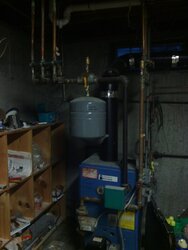Hi Everyone,
Im new to this forum.
Im looking to tie my pellet stove to my oil fired boiler.
Currently looking for a heat exchanger to install in my pellet stove which i think will be the most difficult about this setup.
I was hoping to get some advice for you guys on how to do the plumbing. From what ive read so far it doesnt seem to difficult.
Some specs on my boiler:
Crown Industries BD178
Manual located here.
<iframe src="https://skydrive.live.com/embed?cid...EE59CD598575!111&authkey=ALyT5fy3QqlpVuQ&em=2" width="476" height="288" frameborder="0" scrolling="no"></iframe>
Here is a picture of my setup.

As seen in the picture I have 3 zone valves and one circulator pump.
The pellet stove is a Harman P38 which is located by one zone baseboard.
My intention is to plumb into the zone located by the pellet stove and use the existing zone plumbing to circulate the h20 through the furnace.
I intend to use an aqua-stat at the pellet stove location the trigger the zone valve and circulator pump.
The main reason im going this route is because i have rooms on the other side of the house which are cooler then the side with the pellet stove. I also use the boiler for domestic hot water.
A few questions right off:
The existing piping is 3/4" copper. Im looking at purchasing a stainless steel coil which is about 150" long and 9mm od. will there be a flow issue with the change in the size of the pipe?
Id like to use the zone located in the living room to to circulate the h20 to the furnace and then circulate hot h20 to the bedroom zone. I might be over thinking this but will there be an issue with this? Or will the bedroom zone work as usual and send hot h20 through the baseboard as it is called for?
Will the hydronic system h20 actually heat the tankless heater coil ( installed in the boiler) for domestic hot water as well?
My pellet stove is located a floor above the boiler. Will this be an issue with circulating the h20 or is it irrelevant since i would be using the boiler circulator pump?
Thank you in advance for all the advice!
Im new to this forum.
Im looking to tie my pellet stove to my oil fired boiler.
Currently looking for a heat exchanger to install in my pellet stove which i think will be the most difficult about this setup.
I was hoping to get some advice for you guys on how to do the plumbing. From what ive read so far it doesnt seem to difficult.
Some specs on my boiler:
Crown Industries BD178
Manual located here.
<iframe src="https://skydrive.live.com/embed?cid...EE59CD598575!111&authkey=ALyT5fy3QqlpVuQ&em=2" width="476" height="288" frameborder="0" scrolling="no"></iframe>
Here is a picture of my setup.

As seen in the picture I have 3 zone valves and one circulator pump.
The pellet stove is a Harman P38 which is located by one zone baseboard.
My intention is to plumb into the zone located by the pellet stove and use the existing zone plumbing to circulate the h20 through the furnace.
I intend to use an aqua-stat at the pellet stove location the trigger the zone valve and circulator pump.
The main reason im going this route is because i have rooms on the other side of the house which are cooler then the side with the pellet stove. I also use the boiler for domestic hot water.
A few questions right off:
The existing piping is 3/4" copper. Im looking at purchasing a stainless steel coil which is about 150" long and 9mm od. will there be a flow issue with the change in the size of the pipe?
Id like to use the zone located in the living room to to circulate the h20 to the furnace and then circulate hot h20 to the bedroom zone. I might be over thinking this but will there be an issue with this? Or will the bedroom zone work as usual and send hot h20 through the baseboard as it is called for?
Will the hydronic system h20 actually heat the tankless heater coil ( installed in the boiler) for domestic hot water as well?
My pellet stove is located a floor above the boiler. Will this be an issue with circulating the h20 or is it irrelevant since i would be using the boiler circulator pump?
Thank you in advance for all the advice!

